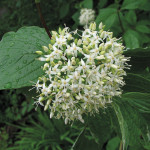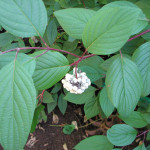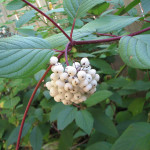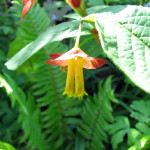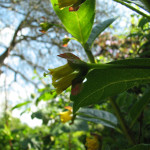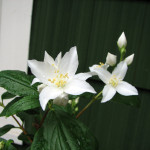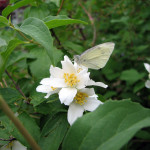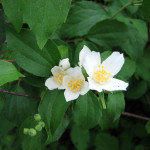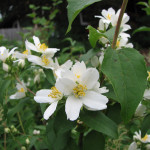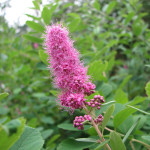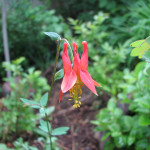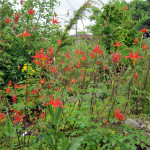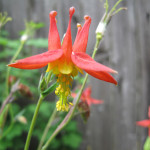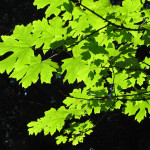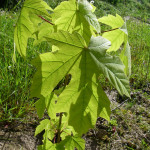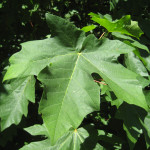Cornus sericea
Red osier dogwood (Cornus sericea) is a medium to tall deciduous shrub. It can grow 6-15 feet tall and 5-10 feet wide depending on site conditions, and spreads to form dense thickets. It is attractive year round with red winter twigs (especially in sunny sites), creamy-white flower clusters, red to purple fall color, and bluish-green to white fruits.
This shrub is excellent for wildlife. Painted lady butterflies visit the flowers for nectar, and spring azure butterflies lay their eggs on the newly developing leaves and buds. Dozens of species of birds and mammals rely on it for food year-round, eating the new shoots in the spring, berries in summer and fall, and twigs through the winter. Birds take cover and nest in the shrubs, and even some amphibians lay more eggs in wetlands with red osier dogwoods than without.
Cuttings readily root, and it is an excellent shrub for improving the health of stream banks and wetlands. In the wild, it commonly grows in wetlands and other habitats with damp soil.
- Light Requirements: Full Sun, Part Shade
- Water Requirements: Moist, Seasonally Wet, Perennially Wet
- Ease of Growing: Easy to grow
- Growth Rate: Fast
- Spreads: Yes
- Wildlife Support: Pollinators, Hummingbirds, Birds or Mammals
- Fire-resistant: Yes
- Edible: No
- Mature Height: 15ft
- Mature Width:6-9ft
Black Twinberry
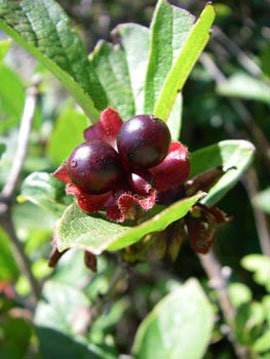
Lonicera involucrata
Black twinberry (Lonicera involucrata) is also known as “twinberry honeysuckle”. Named for its pairs of flowers and fruits, this attractive shrub grows up to 10 feet tall. Tube-shaped yellow to orange flowers bloom April – July, followed by dark purple berries surrounded by showy red bracts. Young branches have yellow bark which age to yellow-brown.
The flowers provide nectar for hummingbirds and bumblebees, and the berries are eaten by numerous birds. Twinberry is also a food plant for the young of Gillette’s Checkerspot butterfly. This wetland plant grows best in sun or partial shade and moist soil.
- Light Requirements: Full Sun, Part Shade
- Water Requirements: Moist, Seasonally Wet
- Ease of Growing: Easy to grow
- Growth Rate: Moderate
- Spreads: No
- Wildlife Support: Pollinators, Hummingbirds, Birds or Mammals
- Fire-resistant: Yes
- Edible: No
- Mature Height: 8-10ft
- Mature Width:4-10ft
Mockorange

Philadelphus lewisii
Mockorange (Philadelphus lewisii) is an elegant native shrub which grows 3-9 feet tall and has a rounded form. The long stems are red when new and fade to gray with age, the older bark shredding in small flakes. Leaves are usually oval, 1-2 inches long, and a medium green.
White flowers start appearing in clusters at the ends of stems after the plant is 3-4 years old. At the height of bloom, older plants are covered in masses of sweet-smelling flowers, which have a scent similar to orange blossoms with a hint of pineapple.
This plant is as popular with wildlife as it is with people. The indra and pale swallowtail butterflies visit it for nectar, as do hummingbirds and many other pollinators. Tiger swallowtails lay their eggs on it. Birds and small mammals eat the seeds and shelter in the foliage.
Mock-orange’s green leaves turn soft yellow in autumn, contrasting beautifully with the dark green of of evergreen huckleberry and red fall foliage of Western viburnum. Add an understory of sword fern for year-round beauty and wildlife value!
- Light Requirements: Full Sun, Part Shade, Full Shade
- Water Requirements: Dry, Moist
- Ease of Growing: Easy to grow
- Growth Rate: Fast
- Spreads:
- Wildlife Support: Pollinators, Pest-eating Insects, Birds or Mammals
- Fire-resistant: Yes
- Edible: No
- Mature Height: 6-10ft
- Mature Width:4-10ft
Douglas Spirea
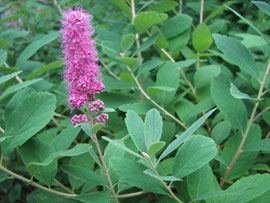
Spiraea douglasii
Also known as hardhack or steeplebush, Douglas spirea (Spiraea douglasii) is best known for its large, pink, pointy clusters of small flowers that bloom from May – July. The flower clusters turn dark in late summer and linger on the plant for months, adding visual interest.
A fast grower that can reach 10-12 feet tall in just a few years, Douglas spirea favors open sunny areas and can tolerate seasonal flooding. It can spread aggressively in moist environments, but is better behaved in drier areas.
Many butterflies visit this plant for nectar and lay their eggs on it, including pale swallowtail, Lorquin’s admiral, spring azure, and mourning cloak.
- Light Requirements: Full Sun, Part Shade
- Water Requirements: Moist, Seasonally Wet
- Ease of Growing: Easy to grow
- Growth Rate: Fast
- Spreads: Yes
- Wildlife Support: Pollinators, Pest-eating Insects, Birds or Mammals
- Fire-resistant: Yes
- Edible: No
- Mature Height: 6ft
- Mature Width:3-7ft
Red Columbine
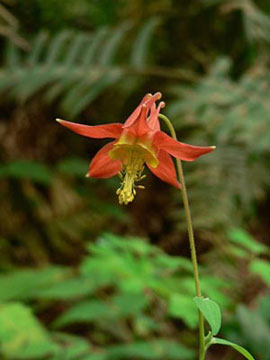
Aquilegia formosa
Red columbine (or Western columbine) is a common and attractive wildflower. It is native to western North America, from Alaska to Baja California and eastward to Montana and Wyoming. The name red columbine is also used for a number of other members of the genus Aquilegia.
Within its range, red columbine can be found across many habitats, including chaparral, oak woodland, and mixed-evergreen or coniferous forest. It prefers moist locations such as stream banks.
The plant grows to 8-48″ in height, averaging around 1-2ft. The red and yellow flowers appear from April to August (with some variation between regions), and are about 5 cm long. The red or orange spreading outer parts of the flower are sepals, and the yellow inner parts are the true petals. The petals bear spurs that attract the plant’s pollinators, sphinx moths.
- Light Requirements: Full Sun, Part Shade
- Water Requirements: Moist
- Ease of Growing: Easy to grow
- Growth Rate: Fast
- Spreads: Yes
- Wildlife Support: Hummingbirds, Pest-eating Insects
- Fire-resistant: Yes
- Edible: No
- Mature Height: 3ft
- Mature Width:1-2ft
Narrow-leaved Mules Ear

Wyethia angustifolia
Also known as “Narrow-leaved Mule’s Ear” or “California Compassplant”. The inflorescence produces one or more large sunflower-like flower heads at the top of the hairy stem. Large lance-shaped, basal leaves with several smaller, alternate, stem leaves.
- Light Requirements: Full Sun, Part Shade
- Water Requirements: Dry, Moist
- Ease of Growing:
- Growth Rate: Moderate
- Spreads:
- Wildlife Support: Pollinators, Birds or Mammals
- Fire-resistant: No
- Edible:
- Mature Height: 2ft
- Mature Width:1ft
Bigleaf Maple
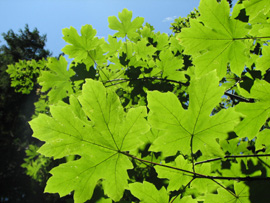
Acer macrophyllum
Acer macrophyllum (Bigleaf or Oregon Maple) is a large deciduous tree with the biggest leaves of any maple. It can grow to nearly 100 feet tall, but more commonly reaches 50-70 feet. It is native to western North America, mostly near the Pacific coast, from southernmost Alaska south to southern California. Some stands are also found inland in the foothills of the Sierra Nevada mountains of central California, and a tiny population occurs in central Idaho.
The palm-shaped leaves are typically 6-12 inches across, with five deeply-incised lobes. The flowers are produced in spring in loose dangling clusters, greenish-yellow with inconspicuous petals. The fruit is a paired, winged, V-shaped samara.
Bigleaf maple is a great wildlife tree. It provides nectar for pollinators, food for the young of tiger swallowtails and mourning cloak butterflies, and shelter for cavity-nesting birds. Mature trees are often covered with moss and ferns which are home to many invertebrates. These miniature ecosystems far above the forest floor capture and filter rain water, and provide food and nest material for birds and small mammals.
Cultivation and Uses
Maple syrup has been made from the sap of bigleaf maple trees. While the sugar concentration is about the same as in sugar maple (Acer saccharum), the flavor is somewhat different. Interest in commercially producing syrup from bigleaf maple sap has been limited.
The lumber from this tree has diverse uses, such as furniture, piano frames and salad bowls. Highly figured wood is not uncommon and is used for veneer and guitar bodies.
- Light Requirements: Full Sun, Part Shade
- Water Requirements: Dry, Moist, Seasonally Wet
- Ease of Growing: Easy to grow
- Growth Rate: Fast
- Spreads: No
- Wildlife Support: Pollinators, Hummingbirds, Pest-eating Insects, Birds or Mammals
- Fire-resistant: Yes
- Edible: Yes
- Mature Height: 90ft
- Mature Width:70ft
Salal

Gaultheria shallon
Salal is a low-growing, leathery-leaved evergreen shrub that tolerates a wide variety of conditions. Its dark blue “berries” (actually swollen sepals) are edible raw and can be made into jams, preserves, and pies. Salal berries are mildly sweet, and are often used in combination with the more tart Oregon grape.
In the Willamette Valley, salal prefers full to partial shade. In coastal areas it can form deep, nearly impenetrable thickets, and easily tolerates full sun. It grows as far north as Baranof Island, Alaska.
Salal leaves are also harvested and sold to florists worldwide for use in floral arrangements.
- Light Requirements: Part Shade, Full Shade
- Water Requirements: Dry, Moist
- Ease of Growing: Easy to grow
- Growth Rate: Moderate
- Spreads: Yes
- Wildlife Support: Pollinators, Hummingbirds, Pest-eating Insects, Birds or Mammals
- Fire-resistant: Yes
- Edible: Yes
- Mature Height: 1-5ft
- Mature Width:1-5ft


